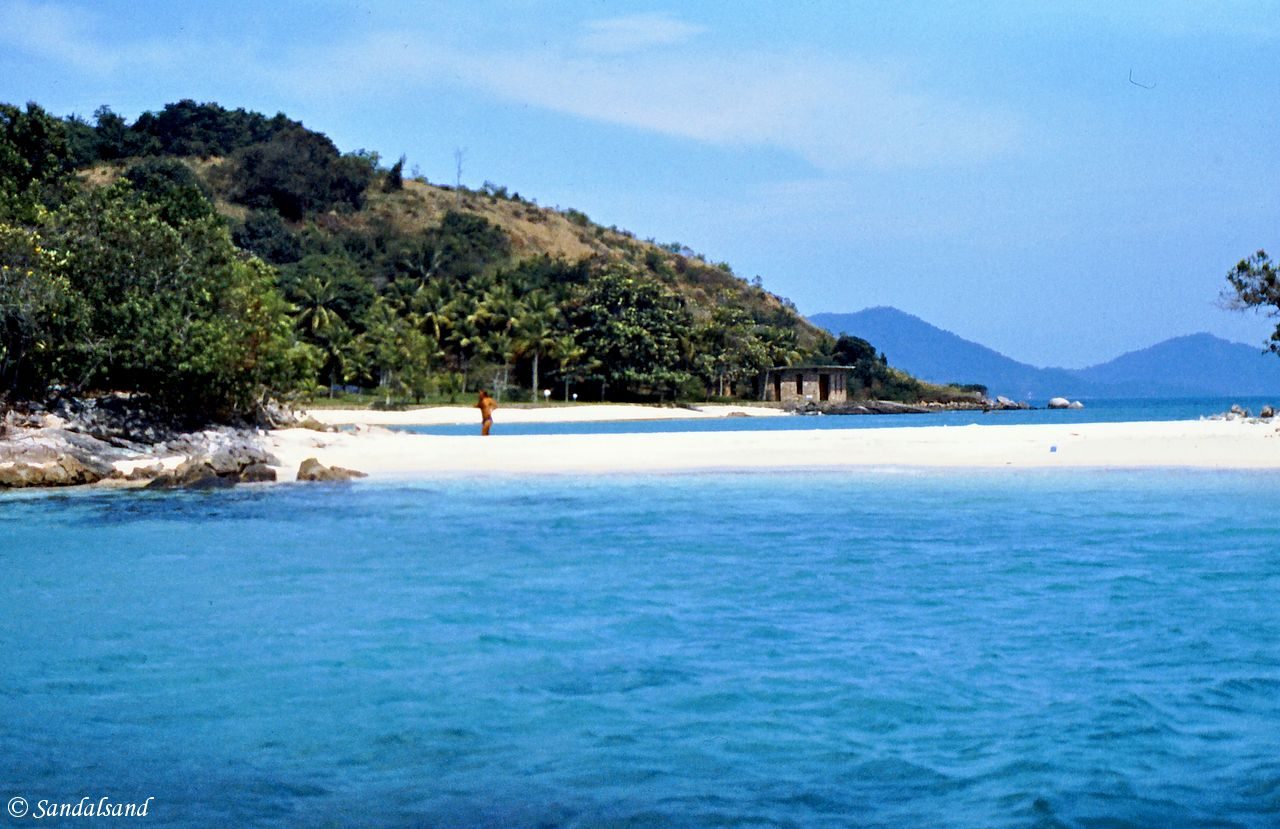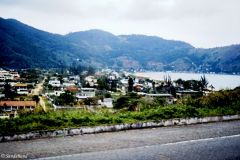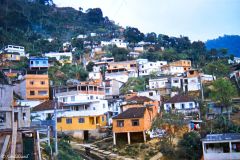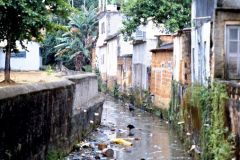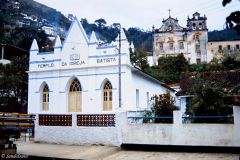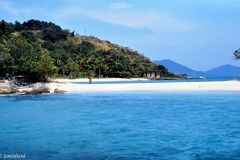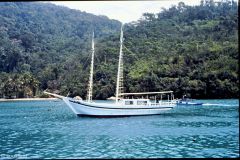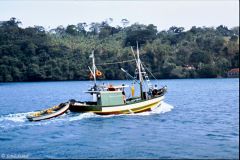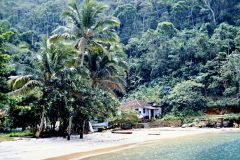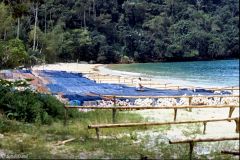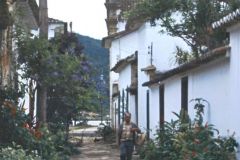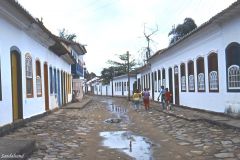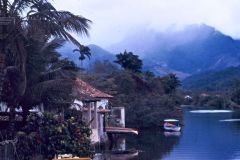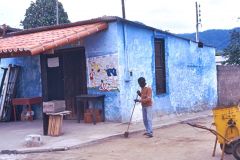We went looking for beaches and old colonial towns south of Rio and found them. We also went on a funny boat trip.
This article is part of a travelogue from of a five month journey in 1987-1988 to several countries in South America: Brazil, Peru, Ecuador, Bolivia, Chile.
Tuesday 29.09.1987, Angra dos Reis
Around nine we went out to the Rodoviària, as all bus stations in Brazil are called. We found a bus toHacuraça, a small place 90 km south of Rio. We had read in our South American Handbook that there would be a cheap hotel on an island outside this little town. Unfortunately it turned out to be no boat connections to this town.
A police officer helped on a local bus a little bit back to Coroa Grande and we got in touch with the ferry man of Hotel Pierre, the place we were trying to reach. As we had no reservation he called the hotel and let me speak to a guy who was able to speak some English. The hotel was fully booked but we would be able to stay with two others in an apartment. When he said the rate I had a shock. 5000 Cz$ (83 USD) was everything but what I expected. A double-check in Spanish/Portuguese gave the same result: cinco-mil something. I said no thank you and hung up.
It turned out that the L price group in our guidebook, which was the one our hotel was placed in, was not the cheapest. It was the other way around. This is what we had paid 52 Cz$ (0.9 USD) for on a bus ticket and spent an hour and half to experience. On the other hand this gave us an opportunity. Further south is Angra dos Reis, recommended by the Brazilian helping us out in the Rio police station, and also recommended by the guidebook.
Getting there
We returned to the main road to a restaurant we knew that the bus company we had travelled with, was frequenting. As buses from Rio to Angra depart every hour we did not have to wait long but we probably had to pay the full Rio-Angra ticket (103 Cz$ (1.7 USD)).
After all this we finally made it to Angra dos Reis in the afternoon and were offered a brochure and tips by a Portuguese speaking tourist information lady at the Rodoviária.
- Hotel Porto Rico (Rua Coronel Carvalho no 54, tel 65-0992). 400 Cz$ (6.6 USD) for a double with extra bed and bath. Shower. Clean, big and a huge bed. Very nice and little noise. A single room is 300 (5 USD), as was our hotel in Rio. No breakfast included, only from 10-12 in the morning which would be too late for us. Map.
We were immediately appealed by Angra dos Reis. It had a small but interesting and active town centre. There were several OK restaurants, although the Labambina which we tried was probably not among the best. It was in short a pleasant little town. The traffic is quite relaxed, not least compared to Rio.
Wednesday 30.09.1987, Angra dos Reis
The tourist information office had recommended a boat trip around the islands in the region. The company offering these trips has two regular daily runs, 10-14 and 15-17 in the afternoon. The first included lunch and a stop at the reportedly beautiful Ilha da Gipóia.
At the ticket office of the company IATE Delta (Tropical Angra Turismo) we were told that there had to a minimum of six persons on the cruise. When we turned up at 10 o’clock unfortunately no one else did.
Therefore: After consulting once again with the information girl we took a local bus (15 min, 10 Cz$, departures every hour, Vila Velho-route from platform 5 on the bus station) to some beaches further south. We passed Bonfim and jumped off at the Grande beach. (We ought to have jumped off right on the beach and not at the hotel on the other end. It was not possible to get down from there.)
On the beach we relaxed and bathed in the heat of the sun the entire day. There were very few people around, practically empty. It was a nice beach but there were a few residential houses around so we felt it was not that big deal. On the other hand we had a reddish tan. Yesterday was a cloudy day with some showers, so it seems to be changing a bit.
Thursday 01.10.1987, Angra dos Reis, Ilha da Gipóia
This was a lucky day in terms of the sea cruise. When we came down to the ticket office we paid each 200 Cz$ (3.3 USD) and boarded the boat. It had a sundeck and after a while we went up there not least to get away from the engine noise on the deck below.
The weather was brilliant and the sun was burning our half-naked bodies. Halfway during the cruise it started to get windy and cloudy, but soon returned to the better.
We were eight passengers on board, only couples. It turned out to be quite amusing as all the other six were newlywed couples, even married on the same day independent of each other. So, we were sitting there in four groups watching one beautiful island and beach after the other. There were obviously rich people who had settled in the area, for some of the houses and gardens looked very nice.
We learned that it was the navy which owned the islands in this region, but private individuals may rent a plot (or island) for a period of, say, 99 years. During the day, and like yesterday, we saw some offshore oil rigs and waiting tankers nearby.
On the island
Around the middle of the cruise we went ashore on an island (Gipóia) for lunch. We had to pay it extra. One of the brides was at attorney and had received private English teaching. She consequently became our interpreter and at the end we had a very good time all eight of us. Later we dived from the boat and really enjoyed the day.
In the evening we had pizza and later beer and Martini in a bar. There are lots of people around but they left around eleven. Pizzas are by the way quite boring, and very fat. The beer, in particular the Antarctica, is pretty good and very cheap, less than a dollar (US) for a half litre.
Let me add that when the boat was returning from the cruise, we picked up a can of marijuana. It was emptied into the sea and was also wet already. We were told that there had been a similar episode in Rio the day before.
In the afternoon we walked around in the centre of Angra dos Reis and took some pictures. My first film is almost finished. We also took a little walk uphill behind the town where some less affluent people (to put it mildly) dwell. The open sewer in the canals attracts some big, black birds; ravens perhaps.
Friday 02.10.1987, Angra dos Reis – Paraty
We took a bus (1.5 hrs, 62Cz$ (1 USD)) a hundred kilometres south along the coast – fine views and scenery with a number of small sandy beaches and fishing villages.
At one point we passed by a nuclear power plant with a small “town” for the workers right next to it. We have seen towns like that other places as well. The factories, shipyards and in this case the power plant – builds up rows upon rows of houses for their workers. The standard seems to vary by their levels of seniority.
It all looks quite stereotypical and without soul: No shops or restaurants only lined up identical residential blocks or detached villas. Quite often the entire area seems to be enclosed by barbed wire. Once we thought we were passing by a prison.
Paraty
Anyway, the destination today was Paraty. In the 1600s this little town was a centre for the gold export to Portugal. Today its old town is a national historic monument in its entirety. This means amongst other that car traffic is prohibited in the central streets. This is kind of smart, the place looks genuinely worth taking care of.
We were using our cameras several times. The streets are narrow; the surface made of cobbled stones (quite large). The buildings are old and well preserved. Naturally this makes Paraty a picturesque and pleasant place to visit. In addition the window frames and doors are painted in clear colours, and there are several nice little shops – for tourists.
In 2019, UNESCO made the city of Paraty and four natural sites around it, a World Heritage Site. Read my entry about it: World Heritage #1308 – Paraty and Ilha Grande – Culture and Biodiversity.
Back in Angra
The weather was sad and when we returned to Angra dos Reis it was raining. We found ourselves a little place to eat. It gets cheap especially now that Bo and I have changed to ordering just one portion. Like I said previously we get so large portions that it is utterly satisfactory. Besides we have all in all used up a little too much money since we came to Brazil and will have to change to a more moderate spending practice.
We rounded the evening off with a couple of bottles of wine in our room.
Saturday 03.10.1987, Angra dos Reis
We stayed in bed longer than we should, considering leaving Angra today. If the weather had been nice we would have gone to the beach. On the contrary we were left to wandering about town and bought bus tickets for Rio for the next morning at 10:30 (103Cz$ (1.7 USD)).
Sunday 04.10.1987, Rio de Janeiro
We checked in at the
- Hotel Marajó once again.
Before that we had bought tickets at the Rodoviário for the 2330 bus on Monday to Ouro Preto (306 Cz$, (5.1 USD) 9 hrs).
In the afternoon we walked into the centre of Rio. “Ghost town” is the term that struck us. No people, only big, wide streets and tall buildings.
Monday 05.10.1987, Rio de Janeiro
We went out the police station in Leblon to pick up the receipt for the police report on the theft of my camera lens. It went fine but we were struck by how little they had done in the eight days they had needed.
We then went over to the Consulate General and had the report translated to Norwegian. There we also took the opportunity to read Norwegian newspapers of a fairly recent date.
In the afternoon we also took Rio’s remaining tramway across an aqueduct and up into the hillside area of Dois Irmaos (1 Cz$) and walked back down again to Santa Teresa and further on to Gloria. It was quite pleasant up there but the view to the favela on the adjacent hillside was equally interesting.
We had fish and wine for dinner at the nice little restaurant right by our hotel.
Read more
The next chapter: Ouro Preto was the centre of the 18th century gold rush. We also visited nearby Mariana before continuing our journey to Belo Horizonte.
Read the introduction to this journey
Click to view a full screen map of the journey

